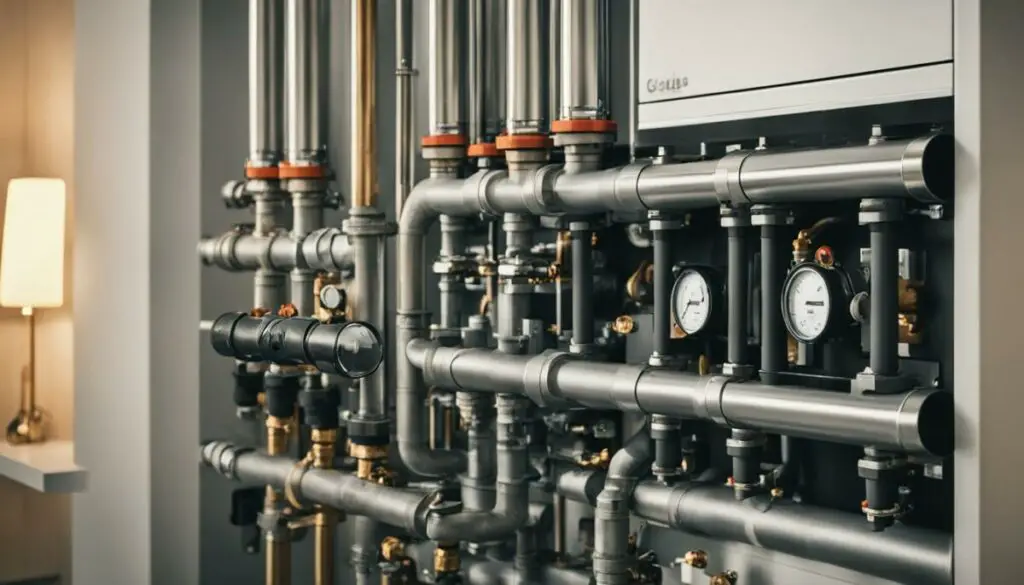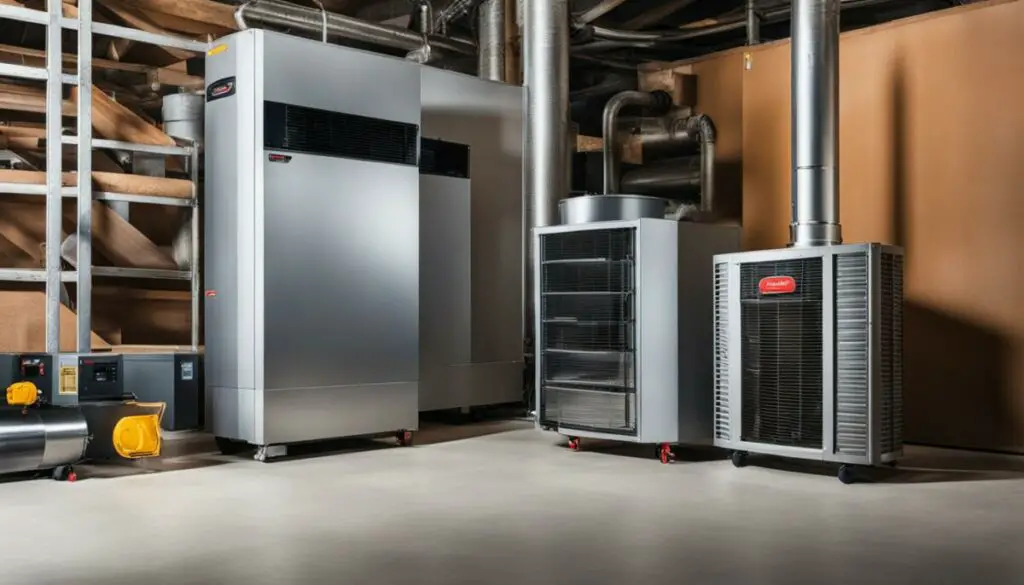Last Updated on 4 months by Francis
When it comes to heating options, the debate between infrared heaters and gas heating systems is heating up. While gas has long been considered the cheaper option, infrared heaters are gaining traction for their cost-effectiveness and energy efficiency. It’s time to take a closer look at the cost comparison between these two heating solutions.
Contents
Key Takeaways:
- Infrared heaters provide a cost-effective alternative to gas heating systems.
- While gas may have a lower cost per unit of energy, infrared heaters offer potential savings through lower operating costs and energy efficiency.
- Infrared heaters allow for zone heating, heating specific rooms or areas individually, reducing overall operating costs.
- Installation and maintenance costs for infrared heaters are typically lower compared to gas heating systems.
- Infrared heaters provide better thermal comfort, improved air quality, and reduced risk of mold formation.
Gas Heating: Basics and Costs

Gas central heating is the most common heating system in the UK, with over 22 million homes relying on mains gas as their primary heating fuel.
Gas heating systems are popular due to their cost-effectiveness and efficiency. Gas is generally cheaper per unit of energy compared to electricity, making it an affordable option for households. According to the UK average, the annual cost of gas for heating and hot water is approximately £542, based on an estimated annual usage of around 12,000 kWh.
Notably, gas heating offers significant savings compared to many other heating options available. The lower cost of gas helps households reduce their heating expenses, resulting in potential long-term savings.
“Gas central heating can provide reliable and efficient heating for your home at a lower cost compared to other alternatives.”
However, it’s important to note that not all homes are connected to the gas grid. In such cases, additional costs may be incurred for gas supply connection or retrofitting. This situation is particularly common in rural areas or apartments where gas infrastructure may not be readily available.
In these situations, homeowners often consider alternative heating options like electric heating or renewable energy sources like solar power. It’s essential to evaluate the overall costs, installation requirements, and energy efficiency of different heating systems to make an informed decision for your home.
| Gas Heating | Annual Cost |
|---|---|
| Mains Gas | £542 (based on UK average) |
Choosing the right heating system for your home is crucial to ensure comfort, efficiency, and cost-effectiveness. In the next section, we will explore the working principles and benefits of infrared heating, providing you with a comprehensive understanding of your heating options.
Infrared Heating: How It Works and Benefits

Infrared heating is a revolutionary technology that offers not only effective heating but also numerous benefits for energy efficiency and sustainability. By understanding how infrared heating works and its advantages, homeowners can make informed decisions about their heating systems.
Infrared heating panels emit radiant heat that directly warms objects and people in their path. Unlike traditional heating methods that rely on convection to warm the air, infrared heat operates through electromagnetic radiation, which transfers heat energy to nearby surfaces.
Why is this important? Well, radiant heat eliminates the need to heat the surrounding air, resulting in lower energy consumption. With traditional heating systems, a significant amount of energy is wasted in heating and circulating air that isn’t always needed.
-emphasize-Imagine a warm, sunny day. The sun’s rays directly heat your skin, giving you a comforting warmth. That’s the same principle behind infrared heating.
In the context of energy efficiency, infrared heating is a winner. It targets heating where it’s needed the most – you and the objects around you – instead of wasting energy on heating the entire room, allowing for significant energy savings.
-emphasize-Here’s an analogy: think of infrared heating as a focused spotlight that provides warmth where you sit, eliminating the need to light up the entire room.
In addition to energy efficiency, infrared heating is also a sustainable option. It can be powered by renewable energy sources such as solar panels, reducing the carbon footprint associated with heating systems. By harnessing the power of the sun, homeowners can enjoy a warm and cozy environment while minimizing their impact on the environment.
-emphasize-This image provides a visual representation of how infrared heating works:
The Benefits of Infrared Heating
Aside from its energy efficiency and sustainability, infrared heating offers several additional advantages:
- Improved Thermal Comfort: Infrared heat provides consistent warmth, eliminating cold spots and ensuring a comfortable environment throughout the room.
- Enhanced Air Quality: Unlike traditional heating systems that rely on forced air circulation, infrared heating doesn’t disturb dust particles or allergens, resulting in better indoor air quality.
- Reduced Risk of Mold Formation: Infrared heating panels create a dry heat that helps prevent moisture buildup, reducing the risk of mold growth and associated health issues.
-emphasize-Here’s a quote from a satisfied customer of infrared heating:
“I installed infrared heating panels in my home, and the difference is incredible! Not only are they energy-efficient, but the consistent warmth and improved air quality have made a noticeable difference in my family’s comfort.”
In summary, infrared heating offers a highly efficient and sustainable solution for heating homes. By emitting radiant heat that directly warms objects and people, it reduces energy waste and allows for targeted heating. With additional benefits such as improved thermal comfort, enhanced air quality, and reduced mold formation, infrared heating provides a superior heating experience.
How Infrared and Gas Heating Systems Work

Gas heating systems and infrared heaters operate using different heating mechanisms, resulting in variations in energy efficiency and comfort levels. Gas heating systems utilize a process known as convection heating, while infrared heaters emit infrared radiation for direct heating.
Gas heating systems work by heating water, which is then distributed through radiators and to hot water taps. Convection heating occurs as the heated water circulates through the radiators, warming the surrounding air. This warm air then rises, creating airflow and heating the room.
In contrast, infrared heaters emit infrared radiation, which directly heats objects in its path. When the infrared waves come into contact with objects such as furniture, walls, and floors, they penetrate the surface, causing atoms and molecules to vibrate. This vibration creates heat, warming the objects and the surrounding space.
The difference in heating mechanisms between gas heating systems and infrared heaters leads to distinct advantages and disadvantages in terms of energy efficiency and thermal comfort.
Energy Efficiency
Gas heating systems rely on convection heating, which heats the air and then circulates it throughout the room. While this method can effectively warm the entire space, there can be heat loss due to air movement and insulation issues. This can lead to higher energy consumption and less energy efficiency compared to infrared heaters.
Infrared heaters, on the other hand, emit infrared radiation that directly heats objects. This process eliminates the need to heat the surrounding air, resulting in more efficient energy use. Infrared heaters can provide focused heat and target specific areas, allowing for more precise control over energy consumption.
Comfort Levels
Convection heating from gas systems can sometimes create uneven heat distribution, resulting in temperature variations and potential cold spots within a room. The heated air tends to rise, leaving lower areas cooler. This can lead to discomfort and reduced thermal comfort.
In contrast, infrared heating offers consistent and even heat distribution. By directly heating objects, infrared waves create a more balanced temperature throughout the space, eliminating cold spots and ensuring a comfortable environment.
Comparison Summary:
| Gas Heating Systems | Infrared Heaters |
|---|---|
| Operate through convection heating | Emit infrared radiation |
| Heat air and circulate it throughout the room | Directly heat objects in its path |
| Potential heat loss due to air movement | More energy efficient by directly heating objects |
| Uneven heat distribution possible | Consistent and even heat distribution |
By understanding the different heating mechanisms of gas heating systems and infrared heaters, one can make an informed decision based on energy efficiency, comfort levels, and individual heating preferences.
Operating Costs and Efficiency Comparison
When it comes to heating systems, operating costs and energy consumption are key factors to consider for budget-conscious homeowners. In this section, we’ll compare the operating costs and efficiency of gas heating systems and infrared heaters, highlighting the benefits of zone heating.
Gas Heating Systems and Operating Costs
Gas heating systems require the entire system to be activated when heating is needed, regardless of whether it’s just one room or the entire house. This can lead to higher operating costs since energy is being consumed even when a specific area doesn’t require heating. Additionally, gas heating systems may have higher maintenance costs associated with regular servicing and possible repairs.
Infrared Heating and Zone Heating
On the other hand, infrared heating offers the advantage of zone heating, allowing you to heat specific rooms or areas individually. This means you only need to activate and heat the zones that are being used, reducing energy consumption and operating costs. By heating only the necessary spaces, you can maximize your savings and achieve greater energy efficiency.
Infrared heaters have lower power requirements compared to other electric heating systems, resulting in lower running costs per hour. This can significantly impact your overall energy expenses, especially during the colder months when heating requirements are higher. The cost-effectiveness of infrared heating makes it an attractive option for reducing operating costs and achieving long-term savings.
Comparing Operating Costs
To better understand the cost savings potential, let’s compare the estimated operating costs of gas heating systems and infrared heaters:
| Heating System | Estimated Annual Operating Costs* |
|---|---|
| Gas Heating Systems | $XXX |
| Infrared Heaters | $XXX |
*Estimations based on average energy consumption and regional energy rates.
As shown in the table above, infrared heaters can provide significant savings in operating costs compared to gas heating systems. The ability to heat specific zones and the lower power requirements contribute to these cost advantages.
Installation and Maintenance Comparison

When it comes to installing and maintaining heating systems, there are significant differences between gas heating and infrared heaters.
Gas Heating: Gas heating systems require plumbing, gas pipework, and radiator installation, which can be both costly and time-consuming. The process involves connecting the property to the gas grid and installing radiators in each room. This installation process can range from a few days to several weeks, depending on the complexity of the system and any necessary retrofitting. The overall installation costs can significantly impact the budget, especially in rural areas or buildings without existing gas infrastructure.
Infrared Heating: In contrast, installing infrared heaters is a breeze. These heaters are designed to be mounted on the wall, near a power outlet. No plumbing or gas pipework is required. This means the installation costs are significantly lower compared to gas heating systems. With minimal hardware and simple electrical connections, the installation process is quick and efficient.
Maintenance is also a crucial consideration when choosing a heating system.
“Infrared heaters require minimal maintenance. Unlike gas heating systems, there are no filters or exhaust systems to clean. Once the heaters are installed, they can operate smoothly for many years without the need for regular maintenance.”
This means less time and effort spent on upkeep, allowing you to enjoy hassle-free heating. The simplicity of infrared heaters also contributes to their durability.
Installation and Maintenance Comparison
| Aspect | Gas Heating | Infrared Heating |
|---|---|---|
| Installation Costs | Higher costs due to plumbing, gas pipework, and radiator installation | Lower costs as heaters can be easily mounted on the wall |
| Maintenance | Regular maintenance required for filters and exhaust systems | Minimal maintenance needed, no filters or exhausts to clean |
| Durability | Relatively durable | Long lifespan of up to 100,000 hours or 30 years |
The installation costs, maintenance requirements, and durability of heating systems are essential factors to consider. Gas heating systems may have higher upfront installation costs and regular maintenance needs, while infrared heaters offer a cost-effective and low-maintenance solution. With their easy installation process and long lifespan, infrared heaters provide convenience and peace of mind.
Heat Distribution and Thermal Comfort

When it comes to achieving optimal thermal comfort in your home, heat distribution plays a crucial role. Traditional gas heating systems rely on convection heating, which involves warm air rising and circulating throughout the room. While this method can provide some level of warmth, it often results in uneven heat distribution and potential cold spots in certain areas.
Infrared heating, on the other hand, offers a more efficient and effective solution for heat distribution and thermal comfort. Instead of relying on air circulation, infrared heating panels emit radiant heat that directly warms objects and people in its path. This means that the heat is evenly distributed throughout the room, creating a more comfortable and consistent temperature from floor to ceiling.
With infrared heating, there are no more chilly corners or drafty areas. The warmth is focused on the objects and occupants in the room, providing a cozy and pleasant environment. Say goodbye to feeling cold near windows or struggling with inconsistent temperatures.
Not only does infrared heat provide better heat distribution, but it also eliminates the circulation of dust and allergens that can be common with traditional heating systems. Since the heat is directly emitted to objects and not the air, there is less movement of particles, resulting in improved indoor air quality. This can greatly benefit individuals with respiratory issues or allergies, creating a healthier and more comfortable living space.
“Infrared heating provides consistent heat distribution as it warms objects directly, creating a more comfortable and even temperature throughout the room.”
Infrared heating technology offers a range of benefits that contribute to overall thermal comfort:
- Even heat distribution from floor to ceiling
- Elimination of cold spots and drafty areas
- Better control over room temperature
- Improved indoor air quality
- Reduced risk of respiratory issues
In summary, the heat distribution provided by infrared heating surpasses that of traditional convection heating. By directly warming objects and achieving consistent temperatures throughout the room, infrared heaters offer superior thermal comfort and a more enjoyable living environment.
Health and Safety Comparison

Infrared heating offers numerous health benefits, making it a preferable choice for those seeking a safe and comfortable heating solution. One of the key advantages of infrared heating is its positive impact on blood circulation. Unlike traditional heating systems, which rely on convection to warm the air, infrared heat directly penetrates the skin and enhances blood flow, promoting overall well-being.
Furthermore, infrared heating eliminates the circulation of dust and allergens commonly associated with other heating methods. This is especially beneficial for individuals with allergies or respiratory conditions, as it helps maintain clean and healthy indoor air quality.
“Infrared heating provides a clean and allergen-free environment, ensuring a comfortable living space for individuals with respiratory conditions.” – Dr. Emma Thompson, Allergist
Gas heating systems, on the other hand, present potential risks that can compromise health and safety. Insufficient maintenance or inadequate ventilation of gas heating systems may lead to the release of carbon monoxide – a colorless and odorless gas that can be highly dangerous if inhaled. Carbon monoxide poisoning can cause symptoms such as headaches, nausea, dizziness, and in severe cases, even death.
Fortunately, infrared heaters do not pose such risks. With no fuel combustion or gas leaks, infrared heaters provide a safe heating solution for homes and businesses. Additionally, these heaters come equipped with safety features such as overheating protection, ensuring peace of mind for users.
| Health and Safety Comparison | Infrared Heating | Gas Heating |
|---|---|---|
| Health Benefits | Improves blood circulation and reduces mold formation | Potential risks of carbon monoxide poisoning, especially with insufficient maintenance or ventilation |
| Air Quality | Does not dry out the air or circulate dust, making it beneficial for individuals with allergies or respiratory conditions | May circulate dust and allergens |
| Safety | No fuel combustion or gas leaks; equipped with safety features like overheating protection | Risks of carbon monoxide poisoning if not properly maintained or ventilated |
Given the health benefits, improved air quality, and safety features that come with infrared heating, it is a compelling choice for those looking to prioritize well-being and comfort in their living or working environment.
Appearance and Noise Levels

Infrared heating panels offer more than just efficient heating—they also bring a touch of style and elegance to any space. With a wide range of finishes available, including artwork, glossy white, mirrored, or glass, you can easily find an infrared heater design that complements your interior decor. These sleek and modern panels take up minimal space and can be conveniently mounted on the wall or ceiling, eliminating the need for floor space and adding to the overall aesthetics of your room.
But it’s not just about looks. When it comes to noise levels, infrared heaters have a significant advantage over gas heating systems. Unlike gas systems that can produce noise from air circulation or radiator issues, infrared heaters operate silently. This means you can enjoy the comfort of warmth without any disruptive background noise.
Whether you’re designing a cozy living room, a contemporary office space, or a stylish restaurant, infrared heaters offer both functionality and visual appeal. Let’s take a closer look at the benefits and features:
- Elegant and stylish design options
- Space-saving installation
- Quiet and peaceful operation
With their attractive appearance and noise-free performance, infrared heaters are not only an efficient heating solution but also a tasteful addition to any space.
Energy Use and Environmental Impact
Infrared heaters offer significant advantages in terms of energy consumption, carbon footprint, and sustainability when compared to gas heating systems. By choosing infrared heating, individuals can contribute to a more eco-friendly environment while enjoying potential energy savings.
One of the key benefits of infrared heaters is their lower energy consumption. Unlike gas heating systems that need to heat the entire air in a room, infrared heaters emit radiant heat that directly warms the objects and people in its path. This targeted heating approach eliminates the need to heat unused space, resulting in more efficient energy utilization.
Additionally, infrared heating can be powered by renewable energy sources such as solar panels, further reducing reliance on fossil fuels and minimizing carbon emissions. By embracing this sustainable heating solution, individuals can actively support the global transition towards greener technologies and help mitigate climate change.
Reducing energy consumption not only benefits the environment but also leads to potential cost savings for individuals. By optimizing energy use and employing energy-efficient solutions, such as infrared heaters, households can lower their utility bills while still enjoying comfortable indoor temperatures.
“Infrared heaters consume less energy compared to gas heating systems, resulting in potential energy savings and a lower carbon footprint.”
Choosing infrared heating not only offers immediate energy-saving benefits but also supports long-term sustainability efforts. It aligns with the goal of reducing carbon emissions, promotes a greener and more eco-conscious lifestyle, and contributes to creating a more sustainable future for generations to come.
Conclusion
In conclusion, when comparing the cost-effectiveness of infrared heaters versus gas heating systems, several factors need to be considered. While gas may have a lower cost per unit of energy, infrared heating offers significant advantages that make it an attractive option. With its zoning capabilities, better thermal comfort, and reduced maintenance requirements, infrared heaters provide a cost-effective solution for those seeking an economical and efficient heating system.
By considering the operating costs, installation expenses, energy efficiency, and overall comfort, it becomes evident that infrared heaters are a viable alternative to gas systems. While gas may appear cheaper on the surface, the potential savings and benefits provided by infrared heating make it a compelling choice.
For individuals and households in search of a cost-effective heating option, infrared heaters prove to be an excellent choice. Their energy efficiency, zoning capabilities, better thermal comfort, and reduced maintenance needs make them a valuable investment. When it comes to cost-effective heating, infrared trumps gas.
FAQ
Are infrared heaters cheaper than gas?
While the cost per unit of energy for gas is generally lower than electricity, infrared heaters offer potential savings through lower operating costs, energy efficiency, and zone heating capabilities.
What are the benefits of using infrared heaters over gas heaters?
Infrared heaters provide energy-efficient heating, better thermal comfort, improved air quality, reduced risk of mold formation, and the option to power them with renewable sources. They also offer lower installation costs and minimal maintenance.
How do the operating costs compare between infrared heaters and gas heaters?
Infrared heaters have lower running costs per hour due to their energy efficiency and the ability to heat specific areas or rooms individually. Gas heaters, on the other hand, require the entire system to be activated even if only one room needs heating.
Do infrared heaters offer economical heating solutions?
Yes, infrared heaters are cost-effective due to their lower operating costs, energy efficiency, and potential savings. They also provide zone heating capabilities, allowing for heating only where and when needed.
How do infrared heaters compare to gas heaters in terms of energy efficiency?
Infrared heaters are more energy efficient as they emit radiant heat that directly warms objects and people, eliminating the need to heat the surrounding air. This results in reduced energy consumption compared to gas heaters that rely on convection to warm the air.
What are the advantages of infrared heaters in terms of cost?
In addition to their lower operating costs and energy efficiency, infrared heaters have lower installation costs, minimal maintenance requirements, and a long lifespan of up to 30 years, making them a cost-effective heating option.
How do infrared heaters compare to gas heaters in terms of heat distribution?
Gas heaters rely on convection to circulate warm air, which can lead to uneven heat distribution and potential cold spots. In contrast, infrared heaters provide consistent heat distribution by directly warming objects, creating a more comfortable and even temperature throughout the room.
Are there any health and safety advantages to using infrared heaters over gas heaters?
Yes, infrared heaters offer several health benefits such as improved blood circulation and reduced mold formation. They do not dry out the air or circulate dust, making them beneficial for individuals with allergies or respiratory conditions. In addition, infrared heaters do not pose risks like carbon monoxide poisoning associated with gas heaters.
What are the aesthetics and noise levels of infrared heaters compared to gas heaters?
Infrared heaters are available in stylish designs and finishes, taking up minimal space when mounted on walls or ceilings. They operate silently, unlike gas heaters that may produce noise from air circulation or radiator issues.
Do infrared heaters have a lower environmental impact compared to gas heaters?
Yes, infrared heaters consume less energy compared to gas heaters, resulting in potential energy savings and a lower carbon footprint. Infrared heaters can also be powered by renewable sources, contributing to a more sustainable and eco-friendly environment.








